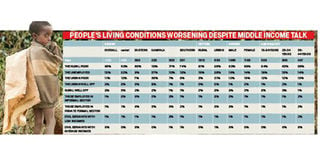Prime
Disaster looms as 11 million Ugandans face starvation

A graphic showing projected phase one of the regions' population and acute food insecurity overview
What you need to know:
- Status. The report indicates that the current state of food insecurity across the country is deteriorating when compared with two previous ones done in November 2015 and July 2016, with the January 2017 showing more Ugandans in food stress or crisis levels.
Kampala. At least 10.9 million Ugandans are facing acute food insecurity with the country risking real disaster should the first planting season rains fail, reveals a new report.
The National Food Security Assessment Report for January 2017, compiled by an Inter-ministerial team, says the number of food-insecure Ugandans may rise to 11.4 million by this month.
The report indicates that the food insecurity that only afflicted 1.3 million people in November 2016, had ravaged 10.9 million people by January 2017, with at least 1.6 million Ugandans already suffering food crisis.
In August last year, the Office of the Prime Minister reported that Karamoja sub-region Kaabong, Nakapiripirit, Moroto, Napak, Amudat, Katakwi, and parts of Serere were facing acute food crisis and were depending on porridge or wild roots and leaves daily without access to a good meal.
Prime Minister Ruhakana Rugunda, while launching the new report at the Serena Kampala Hotel yesterday said the new report reveals that one in every three Ugandans is facing acute food insecurity.
Mr Rugunda blamed the acute food insecurity on the prolonged drought that affected the country in 2015 and part of 2016, but assured Ugandans that government is responding to the challenge.
“And in November 2016, government sent a team of ministers and technical staff to carry out an assessment of the deteriorating food security situation across the country and the national food security assessment report, what I am launching is a product of fact-finding mission by political leaders and inter-agency technical assessment,” Mr Rugunda said.
The report says the current state of food insecurity across the country is deteriorating when compared with two previous ones done in November 2015 and July 2016, with the January 2017 showing more Ugandans in food stress or crisis levels.
Dr Rugunda said with assistance from a joint team of experts, government ministries, the world Bank, Food Agriculture Organisation, World Food Programme, UNICEF and 85 district local governments, government has also worked out a five-year Food Eradication Action plan scaling up irrigation, construction of more valley tanks and large dams.
He said government has also committed Shs25 billion for relief food and is in the process of procuring 1,600 metric tonnes of maize flour and 1,400 metric tonnes of beans.
Mr Rugunda warned that there will be frequent droughts resulting in crop failures and the loss of pasture grazing land for livestock, increased flooding, water logging, erosion, lightning and thunder and declining soil fertility due to climate change and urged the people to adopt irrigation and modern ways of farming.
The new report cites most food-insecure sub-regions as Teso, Karamoja, Bukedi, the cattle corridor, parts of Busoga, Lango, Acholi, West Nile and parts of central Buganda.
The reports says the food insecurity across the country has also created food consumption gaps with falling dietary diversity and rising malnutrition rates affecting 0.58 million children in central region, 0.12million children in Karamoja, 0.2million children in Teso, 0.38 children in East Central and another 0.31 million children in South Central sub-regions.
The minister of Agriculture, Mr Vincent Ssempijja, says the food security situation is getting worse with a population that needs food increasing.
He said government has already put in place strategic food security policy actions categorised as immediate, short, medium and long-term that has costed the country about Shs8.475 trillion for the next four years.
“And this situation requires urgent government intervention before it goes out of hand, we are going to provide food and water from February to May this year,” Mr Ssempijja said.
He said the World Bank has given Karamoja Shs14 billion through Northern Uganda Social Action Fund-3 under cash-for-work programme commonly refered to as Disaster Risk Financing.
The Chinese ambassador to Uganda, Mr Zheng Zhu Qiang, said China has given 5,983 metric tonnes of rice worth Shs22 billion to starving Ugandans.
Interventions
Government.
•Shs25 billion for 1,600 metric tonnes of maize flour
•And 400 metric tonnes of beans [Relief Food].
•Shs8.475 trillion for strategic policy actions for food security in Uganda for next four years.
Donor.
• Shs14 billion given to Karamoja by World Bank through NUFAS 3 under cash for work programme; commonly referred to as Disaster Risk Financing
•Relief Aid worth Shs22 billion worth 5,983 metric tons of Rice from China




